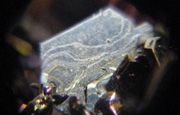Along with the rapid expansion of the fields using semiconductor elements, the functional limits of traditional semiconductors with relatively narrow band gaps, centered mainly around Si, GaAs, etc., have been reached, and there is a strong demand for the development of various kinds of elements via semiconductor materials with wide band gaps such as SiC, as well as the enrichment of basic research into said development, in order to make electronic elements more heat resistant, higher output, and ultra high frequency waves, as well as shortening wavelengths of light emitters.

SiC semiconductor research was vigorously conducted in the 1960s and 1970s, but at the time large and high quality single crystal substrates were not attainable, and practical application was not possible. However, By the 1980s, development of bulk single crystal growth methods and petro-epitaxial growth methods had paved the way for obtaining large single crystal substrates, and with this opportunity, there was again much talk of practical utilization of them, as well as extensive research domestic and internationally into crystal growth and elementization process techniques.
With this, from 1984 SiC research volunteers have gathered together once per year to host an independent research society in order to deepen communication between SiC researchers in our country and promote research.
Subsequently, rapid development in single crystal growth, etc., has been seen, and with the further expansion of applied research into power elements, high-temperature operation elements,, blue light emitting elements, etc., as well as a drastic expansion in the number of researchers, the scope was broadened to include not only SiC but also various types of wide gap semiconductors such as nitride and diamonds, and in 1992, under the Japan Society of Applied Physics, the "SiC and Related Wide Gap Semiconductor Research Society" (the predecessor to this research society--hereinafter called SiC Research Society) was established.
(continued on the following page)
In the more than 20 years since then, SiC Research Society has been aiming for efficient and effective promotion and extensive spreading of research and development into SiC and related wide gap semiconductors, toward innovation in telecommunications, energy, environment, and medical electronics to support the next generation, as well as contributing to the development of the concerned fields by conducting exchanges of information and opinions among researchers by hosting lectures, panel discussions, symposiums, etc., and research trend reviews, discussions regarding crystal growth, physicality evaluation, process techniques, devices, etc., and extensively transmitting the results thereof.
Furthermore, SiC Research Society also makes vigorous efforts as the parent organization operating the international conference on SiC and related materials (International Conference on Silicon Carbide and Related Materials: ICSCRM), fulfilling a vital role in fostering international exchange among researchers as well, to contribute largely to global development in concerned fields.
In recent years, there have been great expectations from the viewpoint of energy conservation regarding the increased efficiency, miniaturization, increased reliability, and new introduction in large quantities of inverters in electric power systems and electric products, industrial machinery and telecommunication machinery power sources, electric railway operation control systems, car electronics, etc. Power electronics has received attention as a technology field to handle the power controls of these.
The key element within this is low loss switching elements, and wide gap semiconductor elements utilizing SiC, GaN, etc., are being researched throughout the world.
Recently, in addition to the remarkable expansion in the performance of switching elements, the importance of conversion circuit accumulation/integration, integrated design technology for modulizing, and circuit implementation technology has been pointed out, and research into electric power control technology has also begun.
(continued on the following page)
In our country as well, in addition to the promotion of energy and resource conservation, with the increase of opportunities toward promoting the implementation and spread of renewable energy, in industry/academia/government, research and development of wide gap semiconductors high quality wafers, devices, and systems is being vigorously advanced, and at the academic society level as well, future technology development relating to wide gap semiconductors from environmental and energy points of view are being coordinated in the Japan Society of Applied Physics academic roadmap as well.

Under such circumstances, once again the importance of physicality clarification for the utilization of the essential characteristics of wide gap semiconductors such as increasing the output of power devices and basic research into material device processes suitable for physicality control and wide gap semiconductors has been recognized.
In SiC Research Society as well, there have come to be a great number of discussions regarding crystals, processes, and device technology with a focus on power electronics applications, and lectures relating to power devices using GaN and diamonds in addition to SiC and the hybridization of Si devices etc., have increased.
And so SiC Research Society, thinking that pivotal discussions should be held to resolve technological issues of sc and related materials and bring reform to power electronics in order to further expand and develop the hereto efforts and respond to the needs of society, reorganized the 2013 "Advanced Power Semiconductor Research Society" and, after discussions and preparations toward the creation of the new subcommittee, has now established the "Advanced Power Semiconductors Division".
This subcommittee will strive to gain the participation not only of researchers of wide gap semiconductors such as SiC, nitride, and diamond but also researchers, etc., of Si-type semiconductors which carry the core of practical devices and host lectures where researchers from broad-ranging fields relating to advanced power semiconductor can come together, panel discussions on individual themes, etc., while also implementing such young human resource cultivation and support operations as tutorials as appropriate, and through these activities, carve a path toward the resolution of fundamental issues affecting each field such as crystal growth, crystal/physicality evaluation, elementization process, element creation/evaluation, and system development of advanced power semiconductors, and contributing to the development of power electronics and the creation of a very energy-conserving society which utilizes them and the realization of low-carbon society.